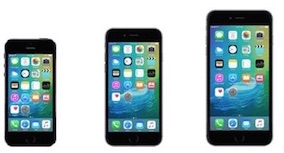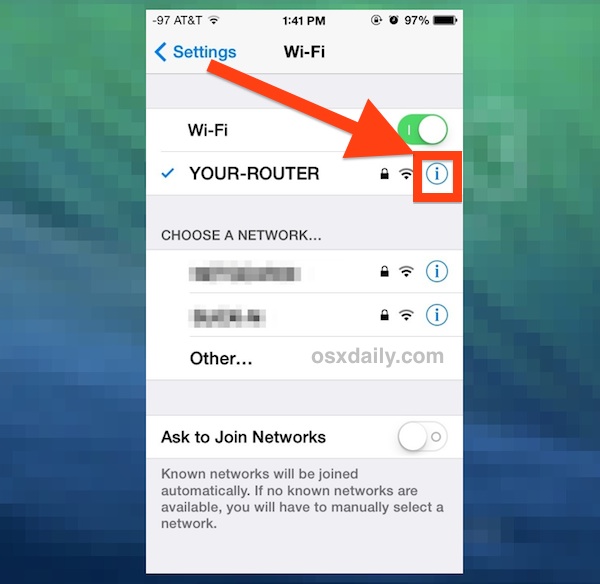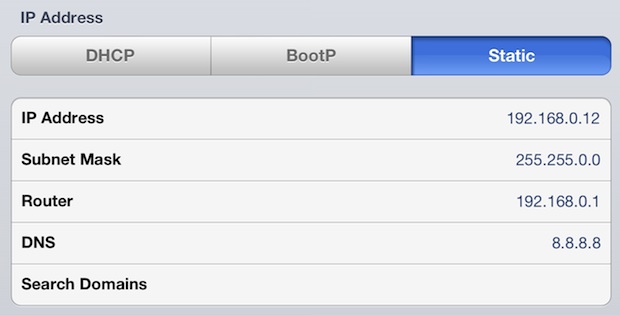How to Set Manual DHCP and Static IP Address on iPad or iPhone

Certain Wi-Fi networks require clients to use static IP addresses or manual DHCP information in order for a device to connect properly to that network. Adjusting the iPhone, iPad, or iPod touch to use a static IP address or manual DHCP settings is easy in iOS, here’s how you can do it with any version of iOS software.
How to Set a Static IP Address & Manual DHCP on iPhone or iPad in iOS
- Tap on “Settings” and then tap on “General”
- Tap “Wi-Fi” and look for the network name you are connected to, then choose the little (i) button or arrow arrow next to it to get more information about that network
- Tap the “Static” tab
- The “Static” section is where you enter network appropriate DHCP info and static IP address information*
- Close out of Settings, and launch Safari or another network app to confirm connectivity

On iPhone and iPod touch, manual network settings look like this:

On an iPad the static IP network information looks like this:

Settings are applied automatically after all the information is typed in, if you need an easy to remember DNS try using Google’s 8.8.8.8 server, which is fast, efficient, and has very high reliability.
* How do you know what IP to choose? This varies. Be sure to choose a manual IP address that is outside the range of other devices on the network as to avoid conflicts. For example, if the router is ‘192.168.0.1’ and there are five devices on the network, picking a static IP outside that range, like “192.168.0.25” would likely be in the clear. If you’re not sure what static IP, subnet mask, router, and DNS to enter, find out from the network administrator, sysadmin, ISP, or the request for manual IP entry.
I’ve had to set manual DHCP information in order to connect iPads to certain older Wi-Fi networks on more than one occasion, something I’ve encountered in Mac OS X Lion before as well.
This makes setting a static IP a fairly reliable network troubleshooting trick when certain iOS devices are having problems with very specific routers and networks, since sometimes the problem is either a conflict with another IP, or just an issue with how certain router firmware behaves with iOS.
The screenshot above demonstrates this used on an iPad and on an iPhone, but the method is the same on any iPad, iPhone, and iPod touch as well, and the settings are universal for all versions of iOS.
Finally, if you’re assigning manual network IP information an you need to set a static IP address on a Mac, you can do that too quite easily.


Put on your Airdrop for the incorrect password
There is no static tab on iOS 12 for ipad
You have to choose the Manual settings, then select Static to get access to Static IP address on iPad and iPhone if you want to set a manual static IP address
I am trying to change it but it it still on automatic
I have list all info on my cell iPhone and ipad how can i get it back
Can any one respond to George’s query which he posted on 19 July 2015. I would like to get answer for it, coz I do face the same problem in my iPad, wherein after entering details in static box, all the info is getting disappeared in static box immediately
I have the same problem too.
Nowhere did you explain where you came up with the IP Address in the first box…. which in one screenshot is 192.168.1.6 and is .12 in another. Where did that number come from? (All you say is to enter the “appropriate” numbers)
This has the potential to be super-helpful but when you make the incorrect assumption that people will “just know” half of what you did, then it becomes an unsuccessful tutorial.
Thanks for the effort and looking forward to the reply.
You’ll want to pick an IP number that is compatible with the router DHCP assignment but far outside the assignment range so that it does not conflict. This is where it gets a bit more technical, in most situations where iOS users are required to set a manual static IP address they will receive that IP number from their network administrator or a sysadmin.
Let’s say your router is at ‘192.168.0.1’ and would assign 192.168.0.2-100 though, and you have three computers on the network (192.168.0.2-4) then pick something far outside the range for the manual IP, like “192.168.0.75”
You can log into the router or gateway too if need be and determine the range.
My iPhone 6 stopped connecting to the internet today. Up ’till now, it connected automatically. When I manually select the my network, it asks for my password. When I enter it, I get an incorrect password message. My other cell phone, my iPad, and desk top computer are all connected as normal. I followed your set up instructions, and it did not connect automatically, and manually, I still get the password problem. When I open static again, all the info I put in is gone. how do I save this info.
George.
I have the same problem. Did your issue get resolved? Please help.
Le lov
[…] to the same wireless network router, be sure no IP conflicts exist. If an IP conflict is found, use manual DHCP and set a static IP far out of the conflict […]
[…] IP address from a router that any iPhone, iPad, or other iOS device is connected to, you can either set a manual IP address or, what’s likely more relevant to most people, you’ll want to renew the DHCP lease […]
set the DNS to the router (192.168.0.1 in the example) may well be faster than googles
Static worked perfectly!
Can I set up several WiFi networks SSIDs with static IP data on the iPhone and remember them for later use?
Yes you are, try it and will be work perfectly…cheers
I’ve had issues in the past with ‘DHCP with manual address’ configuration using my AT&T U-verse router as the DHCP server. When the DHCP lease expired, iOS and Mac OS clients set to ‘DHCP with manual address’ completely lost the ability to route, by name or IP. I would avoid ‘DHCP with manual address’ configuration if you use your AT&T U-verse router as your DHCP server.